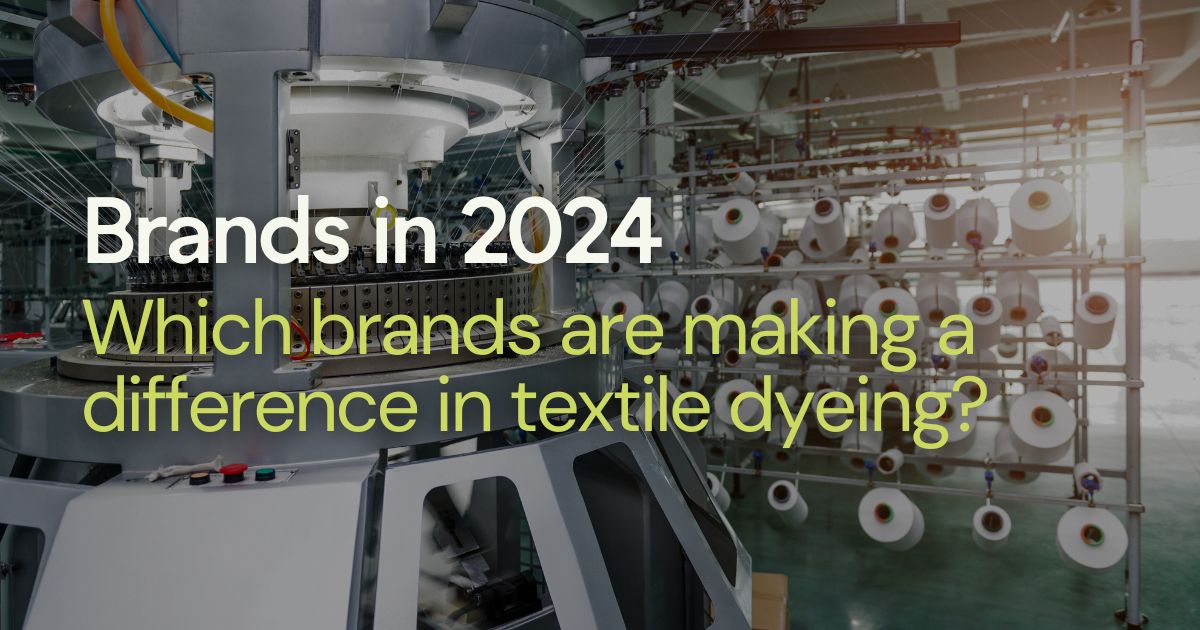
2024 has been a pivotal year for the global fashion industry, having been faced with significant challenges and opportunities. With the urgency of sustainability and evolving market dynamics, brands are re-evaluating their strategies to align profitability with environmental responsibility. A critical area under the spotlight is textile dyeing and finishing, a historically resource-intensive and pollutive segment of the fashion supply chain.
Here, we explore the leading brands driving innovations in sustainable dyeing and finishing, addressing environmental, social, and governance (ESG) goals, and shaping a more sustainable future for textiles.
We at Alchemie Technology are pioneering solutions to build the textile factory of the future. Our digital dyeing systems enable precision dye application and significantly reduce energy, water and chemical use, minimising waste and shortening production times. Visit Our Technologies to discover more.
The Need for Sustainability in Textile Dyeing and Finishing
Environmental Impact
Textile dyeing and finishing is one of the biggest polluters on the planet, generating over 3% of global CO2 emissions. These emissions are largely cause from the industry using high energy-intensive processes, increasing carbon emissions, and exacerbating climate change. Therefore, action needs to be taken to prevent textile dyeing being responsible for 10% of global CO2 emissions by 2050.
Regulatory Pressures
In light of Global Textile Policies in 2024, more and more countries’ textile regulations will mandate supply chain transparency and accountability (such as, in the EU, unsold stock and prohibit the destruction of unsold textiles). These regulations will push brands to adopt sustainable practices, emphasising waste reduction and transparency.
Consumer Expectations
Modern consumers are becoming increasingly environmentally conscious, demanding sustainable fashion. However, many consumers are reluctant to pay significant premiums for sustainable goods, creating a challenge for brands to balance costs and consumer appeal.
Key Brands Leading the Charge
Although there are challenges ahead, below are a selection of brands that have taken the leap and are now leading the charge into 2025 in making the future of textile dyeing more sustainable.
- Inditex (Zara)
- Inditex are on-track for 100% of their textile products to only use sustainable, low impact materials by 2030. The company collaborates with innovators like us at Alchemie Technology to enhance their dyeing and finishing processes.
- H&M Group
- Another of our partners – H&M – is among these leading brands due to their H&M Conscious Collection, demonstrating a commitment to sustainable fashion. The brand invests in partnerships with technology providers and uses traceable dyeing methods to monitor and reduce their environmental impact.
- Levi Strauss & Co.
- Known for their Water<Less® technology, Levi’s has revolutionised the denim finishing process, reducing water use by up to 96% in certain styles. The company is expanding these practices across their product lines over the coming years.
- Patagonia
- Patagonia’s long-standing commitment to sustainability includes the use of low-impact dyes and collaborations with suppliers to ensure adherence to strict environmental standards.
These brands drive long-term sustainability by reassessing materials, collaborating with suppliers, and sharing financing initiatives. Their efforts ensure competitiveness in both textiles and fashion, urging others to scale sustainability while balancing profit and environmental responsibility.
Challenges in Scaling Sustainable Practices
Fragmentation Across the Value Chain
The supply chain involves numerous stakeholders, from raw material producers to textile dyeing mills. Aligning sustainability practices across this fragmented landscape will be a significant challenge for 2025 and beyond.
Cost Implications
Sustainable dyeing technologies often require substantial upfront investments, which can be prohibitive for smaller manufacturers and brands.
However, through partnering with Alchemie Technology, we will together with you and other brands and suppliers to support you in achieving your ESG goals as part of your sustainability journey.
Consumer Price Sensitivity
Despite the demand for sustainable fashion, price sensitivity remains a barrier. Brands must find cost-neutral solutions to maintain affordability.
Looking Ahead to 2025
The transition toward sustainable textile dyeing and finishing is no longer optional. It is a necessary evolution for brands aiming to remain competitive while fulfilling their environmental and social responsibilities. Industry leaders – such as Inditex and H&M – are already demonstrating the potential of waterless technologies and energy-efficient processes, offering a blueprint for others to follow.
We at Alchemie Technology are keen to collaborate with forward-thinking brands to help you achieve your ESG goals. Together, we can redefine textile dyeing and build a more sustainable future.
Connect with us and let’s collaborate – enquiries@alchemietechnology.com